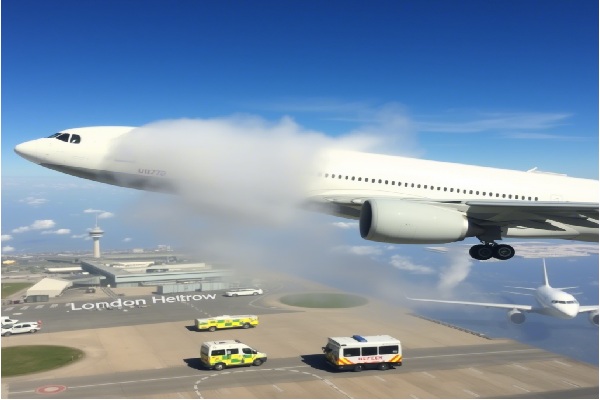On May 28, 2025, a routine transatlantic flight made headlines when United Airlines Flight UA770 declared a general emergency mid-air and made an unscheduled landing at London Heathrow Airport. The sudden event caught the attention of both travelers and aviation enthusiasts, quickly becoming a trending topic.
The emergency involved the flight sending out a “Squawk 7700” — a universal distress signal that tells air traffic control something serious is happening onboard. If you’ve ever wondered what that really means or why it matters, this article is for you.
Let’s break it down: what happened on UA770, what Squawk 7700 actually is, and how these aviation codes help keep passengers safe in the sky.
What is Squawk 7700 and Why Is It So Important?
In aviation, “Squawk 7700” is a four-digit transponder code used to declare a general emergency. When a pilot punches in this code, it immediately alerts every air traffic controller in range that something urgent is happening on that aircraft — and they need help.
This code is used for a wide variety of situations, including:
-
Mechanical failure
-
Medical emergencies
-
Smoke or fire onboard
-
Cabin pressure loss
-
Any event that could threaten the safety of the flight
It doesn’t tell ATC what the exact issue is — just that the situation is critical and requires immediate support.
What Happened on United Airlines Flight UA770?
Flight UA770 was scheduled to travel from Barcelona El Prat Airport (BCN) to Chicago O’Hare International Airport (ORD) on a Boeing 787-9 Dreamliner.
Sometime mid-flight, the crew identified an issue serious enough to declare an emergency. They entered Squawk 7700 into the aircraft’s transponder, which instantly signaled their need to divert.
The flight landed safely at London Heathrow Airport at 4:55 PM BST, using Runway 27R. Passengers were able to deplane without incident, and no injuries were reported. The cause of the emergency has not been publicly disclosed.
How Do Transponders and Squawk Codes Work?
To understand why Squawk 7700 is so effective, it helps to know how transponders function.
Every commercial aircraft is equipped with a transponder, an onboard device that sends real-time data to radar stations on the ground. It tells air traffic control:
-
The aircraft’s position
-
Altitude
-
Identification number
-
Emergency status (via squawk codes)
Squawk codes are four-digit numbers that pilots input manually to signal specific types of emergencies.
Here are the three most important ones:
-
7700: General emergency
-
7600: Communication failure
-
7500: Hijacking or unlawful interference
Once a code is entered, ATC responds based on the severity and nature of the emergency.
Why Squawk 7700 Was the Right Move for UA770
When the crew of UA770 decided to declare a general emergency, they didn’t take it lightly. Sending out a 7700 squawk is reserved for urgent but non-specific threats to the flight’s safety.
This decision allowed air traffic controllers to:
-
Clear nearby airspace
-
Prioritize UA770’s landing
-
Prepare emergency crews on the ground
-
Reroute other flights, if necessary
This proactive approach likely helped ensure the flight’s safe and smooth landing at Heathrow, one of the most equipped international airports in the world.
Also Read : United Airlines Flight UA770 Declares Emergency, Diverts to London Heathrow
How Dangerous is Squawk 7700, Really?
Let’s get one thing straight: just because a plane squawks 7700 doesn’t mean it’s in immediate danger of crashing.
In fact, most squawk 7700 events end safely. The code simply means the flight crew needs extra attention or support to prevent something worse from happening.
According to data from FlightRadar24, over 99% of Squawk 7700 cases result in safe landings and are handled without harm to passengers or crew. It’s a precautionary tool — not necessarily a sign of disaster.
Real-World Aviation at Work: UA770’s Diversion
The incident involving United Flight UA770 serves as a textbook example of how emergency protocols work.
Here’s what we know:
-
The flight diverted from its original route to Chicago.
-
The Boeing 787-9 landed safely in London.
-
Emergency crews were on standby but not needed.
-
All passengers deplaned safely, with no injuries reported.
While we may not know the exact cause, the situation was handled efficiently — proof that aviation safety systems are robust and effective.
Why Heathrow Was Chosen Over Other Airports
A common question after the incident was: “Why divert to London Heathrow and not a closer airport?”
Here’s why Heathrow was the logical choice:
-
It’s one of the major hubs for United Airlines in Europe.
-
It has long runways that can handle wide-body jets like the Boeing 787-9.
-
The airport is well-equipped with emergency response teams.
-
It offers fast passenger processing, customs support, and rebooking infrastructure.
All of these factors made Heathrow the safest and most efficient diversion option under the circumstances.
Aviation Safety Training: How Crews Prepare for Emergencies
This event also highlights the importance of rigorous emergency training for pilots, controllers, and airline staff.
Flight schools and aviation academies — like Spartan College and others — use realistic simulations to train pilots to handle everything from engine failure to loss of communication. These training programs include:
-
Learning squawk codes and when to use them
-
Emergency descent procedures
-
Evacuation protocols
-
Coordinating with ATC during diversions
Thanks to this intense preparation, incidents like the one on UA770 are handled with skill and confidence.
A Quick Look at the Flight and Timeline
| Detail | Information |
|---|---|
| Flight Number | UA770 |
| Airline | United Airlines |
| Aircraft Type | Boeing 787-9 Dreamliner |
| Aircraft Registration | N26902 |
| Departure Airport | Barcelona El Prat (BCN) |
| Destination | Chicago O’Hare (ORD) |
| Diversion Airport | London Heathrow (LHR) |
| Emergency Code Used | Squawk 7700 |
| Landing Time at LHR | 4:55 PM BST on May 28, 2025 |
| Runway Used | 27R |
| Injuries Reported | None |
| Status | Cause under investigation |
Past Misunderstandings Involving Squawk Codes
There have been rare instances where squawk codes were accidentally triggered, causing unnecessary panic.
One well-known example occurred on September 11, 2001, when a Korean Air flight mistakenly activated a hijacking code (7500), prompting a military response. Although it turned out to be a false alarm, it shows why proper squawk code training is so critical.
These codes are powerful tools — but they must be used accurately.
Conclusion: Why Squawk 7700 Matters More Than Ever
The emergency diversion of United Flight UA770 is a great reminder of just how much goes on behind the scenes to keep flights safe.
Even when something unexpected happens, systems are in place:
-
To signal trouble
-
To prioritize safety
-
To land planes safely
-
To get passengers where they need to be
Squawk 7700 isn’t a reason to panic — it’s a sign that aviation teams are doing their job. The safe landing of UA770 at Heathrow proves that even when the skies throw a curveball, modern aviation is ready to catch it.
Frequently Asked Questions (FAQs)
What does Squawk 7700 mean in aviation?
Squawk 7700 is a universal emergency code used by pilots to alert air traffic control of a serious but non-specific emergency. It signals the need for immediate attention and support.
Is Squawk 7700 always dangerous?
Not always. While it indicates an emergency, most cases are precautionary and end in safe landings. The code helps ensure quick coordination and avoids escalation.
What happened to United Flight UA770?
On May 28, 2025, UA770 declared a general emergency mid-flight using Squawk 7700. The flight diverted to London Heathrow and landed safely. The cause has not been officially disclosed.
What are the differences between Squawk codes 7500, 7600, and 7700?
-
7500: Hijacking or unlawful interference
-
7600: Loss of radio communication
-
7700: General emergency
Each code triggers a different response from air traffic control based on the type of threat or issue.
Can the public see if a plane is squawking 7700?
Yes. Websites like FlightRadar24 and FlightAware display real-time flight information, including squawk codes. When a plane uses 7700, it’s often flagged with an “Emergency” tag visible to the public.



